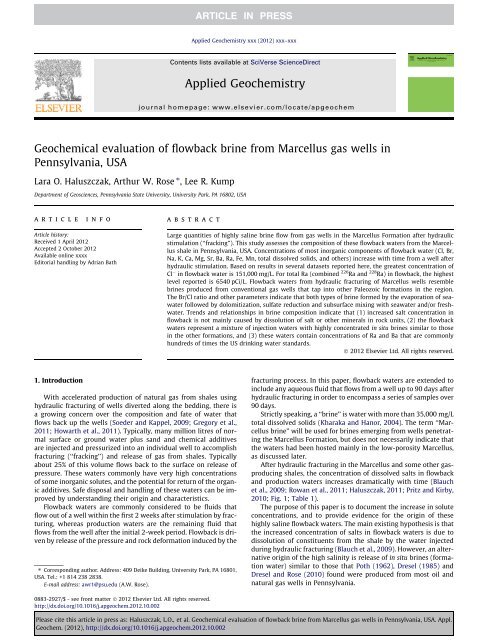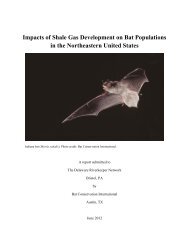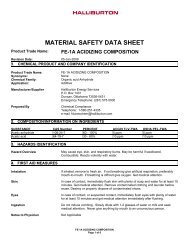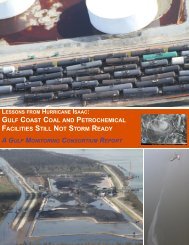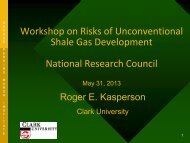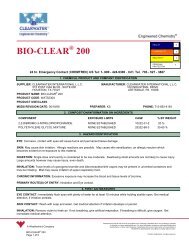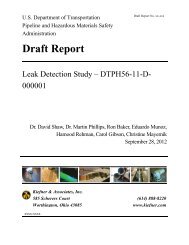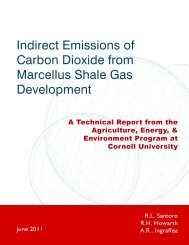Geochemical evaluation of flowback brine from Marcellus gas wells ...
Geochemical evaluation of flowback brine from Marcellus gas wells ...
Geochemical evaluation of flowback brine from Marcellus gas wells ...
You also want an ePaper? Increase the reach of your titles
YUMPU automatically turns print PDFs into web optimized ePapers that Google loves.
L.O. Haluszczak et al. / Applied Geochemistry xxx (2012) xxx–xxx 5<strong>of</strong> <strong>brine</strong> <strong>from</strong> oil <strong>wells</strong>; the remaining 26 <strong>of</strong> the Dresel samples are<strong>from</strong> <strong>gas</strong> <strong>wells</strong>. There are 17 hydr<strong>of</strong>ractured <strong>Marcellus</strong> <strong>wells</strong> <strong>from</strong>the DEP BOGM well data.6Halite dissolutionA4. Results5Fig. 1 illustrates the Cl content <strong>of</strong> <strong>flowback</strong> water <strong>from</strong> eighthorizontal <strong>Marcellus</strong> <strong>wells</strong> <strong>from</strong> Hayes (2009), plus Well B <strong>of</strong>Blauch et al. (2009). Flowback waters <strong>from</strong> these <strong>wells</strong> <strong>of</strong> the GTIseries show a major increase in Cl as later <strong>flowback</strong> waters are returned<strong>from</strong> the well over the 14 days <strong>of</strong> the <strong>flowback</strong> period(Fig. 1), though one sample drops to lower values at 14 days. Thelater concentrations in others are many times the seawater concentration<strong>of</strong> 19,000 mg/L. The median Cl content in the eight samplesincreases <strong>from</strong> 82 mg/L in the injected water to 98,000 mg/L inthe 14-day <strong>flowback</strong>. A further increase is observed for the four<strong>wells</strong> sampled at 90 days. Other significant constituents showingincreased concentration in later <strong>flowback</strong> water are Na, Ca, Mg,Br, Ba, Sr, Fe, Mn, K and total dissolved solids (TDS) (Table 1), aswell as Ra (Rowan et al., 2011). Many minor elements, includingB and Li are also enriched. The pH remains near neutrality in the<strong>flowback</strong>.Sulfate decreases in the <strong>flowback</strong>, probably because SO 4 is verylow in the in situ <strong>brine</strong>. The low SO 4 allows high contents <strong>of</strong> alkalineearth elements (Ca, Sr, Ba, Ra). Alkali elements (Na, K, Li) andhalides (Cl, Br) are generally greatly enriched.The data <strong>from</strong> Blauch et al. (2009) also show greatly increasedconcentrations <strong>of</strong> Cl and other constituents as <strong>flowback</strong> progressesafter hydraulic fracturing. Blauch et al. (2009) show astrong correlation <strong>of</strong> increased Ca with Cl for well A.Hayes (2009) reports low concentrations <strong>of</strong> Cl, TDS and otherconstituents in the injected water at most <strong>of</strong> the <strong>wells</strong>, in the range<strong>of</strong> local surface and shallow ground waters. For a few, the injectedwater evidently consisted partly <strong>of</strong> <strong>flowback</strong> water <strong>from</strong> previous<strong>wells</strong>, based on elevated Cl, Ca, Ba and other elements. Both the injectedwaters and the <strong>flowback</strong> have pH in the range 6–8, indicatingthat dissolution <strong>of</strong> rock minerals by an acidic solution does notexplain the increased cation concentrations. Low contents <strong>of</strong> Cl andSO 4 as well as near-neutral pH in the injected water indicate thatHCl and H 2 SO 4 were not components <strong>of</strong> the injection fluid, and thatacid attack by the injected water does not explain the high concentrations<strong>of</strong> cations in the <strong>flowback</strong> water.A map <strong>of</strong> the Cl content <strong>of</strong> <strong>flowback</strong> was examined. Basedmainly on the Dresel data, an area <strong>of</strong> low Cl in water <strong>from</strong> oil <strong>wells</strong>appears to exist in part <strong>of</strong> NW PA, but other regions seem to havegenerally high Cl and TDS in both conventional <strong>gas</strong> well and <strong>Marcellus</strong><strong>flowback</strong> <strong>brine</strong>s.Carpenter (1978) and others (Stoessel and Moore, 1983; Dresel,1985; Steuber et al., 1998; Kharaka et al., 1987; Connelly et al.,1990; Gupta et al., 2011) used a plot <strong>of</strong> Br vs. Cl to examine therelationship <strong>of</strong> <strong>brine</strong>s to evaporated seawater (Fig. 4). Evaporation<strong>of</strong> seawater leads to enrichment in both Cl and Br during initialevaporation and precipitation <strong>of</strong> calcite and gypsum, but when haliteprecipitates, the halite contains much lower Br than the associated<strong>brine</strong>, leading to a nearly horizontal trend for the residual<strong>brine</strong> on the graph. Because <strong>of</strong> this effect, <strong>brine</strong>s with high Br/Cl result<strong>from</strong> evaporation <strong>of</strong> seawater past the point <strong>of</strong> halite precipitation.These highly evaporated <strong>brine</strong>s may then be diluted byfresh water, sea water, other <strong>brine</strong>s or injected water to produce<strong>brine</strong>s plotting at Br values greater than the seawater evaporationcurve. In contrast, later dissolution <strong>of</strong> the low-Br halite would leadto lower Br/Cl in the <strong>brine</strong>.The Cl–Br plot was used by Dresel (1985) and Dresel and Rose(2010) to show that the conventional <strong>brine</strong>s in Pennsylvania werederived <strong>from</strong> highly evaporated seawater that had been diluted43SWFresh waterdilutionSeawaterdilution0 1 2 3 4with fresh water or seawater (Fig. 4). A contribution <strong>from</strong> halitedissolution is possible, though probably minor.Plotting the <strong>Marcellus</strong> <strong>flowback</strong> waters on this graph indicatesthat they also can be explained as mixtures <strong>of</strong> highly evaporated<strong>brine</strong> with more dilute water (Fig. 4). Using the seawater and freshwatermixing lines Dresel (1985) presented in the original figure,both the conventional <strong>brine</strong> and the <strong>flowback</strong> waters plot in positionsthat indicate dilution <strong>of</strong> an original <strong>brine</strong> with freshwater,seawater or injected fracturing fluid.The <strong>Marcellus</strong> waters plot to the high-Br side (low Cl/Br) <strong>of</strong> theseawater evaporation path, indicating that halite dissolution is notthe major source <strong>of</strong> Cl , as was proposed by Blauch et al. (2009).The halite observed in <strong>Marcellus</strong> cores by these workers may haveprecipitated by evaporation <strong>from</strong> pore fluid on removal <strong>of</strong> the core<strong>from</strong> the well, but except for one sample, halite dissolution cannothave been a major process in the formation <strong>of</strong> the <strong>Marcellus</strong> <strong>brine</strong>s.Gupta et al. (2011) show that highly evaporated seawater canbe diluted and then dissolve appreciable halite but still remain belowthe seawater evaporation curve. They show that in the Albertabasin, <strong>brine</strong>s plotting below the curve are mixtures <strong>of</strong> four processes:seawater evaporation, dilution by fresh water, dilution byseawater and halite dissolution. Thus, halite dissolution can be acontributing process for waters plotting below the seawater evaporationcurve, but must be subordinate to the evaporation effects.Based on the results <strong>of</strong> the Cl–Br plot, the <strong>Marcellus</strong> <strong>flowback</strong>water is considered to have developed analogously to the conventional<strong>brine</strong>s, by evaporation <strong>of</strong> seawater into the halite stage, andthen dilution to the present composition. Most <strong>of</strong> the samples fallnear dilution curves for the Composition A postulated by Dreseland Rose (2010) to have been the parent evaporated seawater<strong>brine</strong>, as shown in Fig. 4. Some scatter to lower Br could be interpretedas halite dissolution.Graphs <strong>of</strong> both Ca and Mg vs. Br show clear similarities betweenthe conventional <strong>brine</strong>s and the <strong>flowback</strong> waters (Fig. 5). Calciumand Mg show a positive linear relation with Br, which is relativelyconservative during evaporation and dilution. The <strong>flowback</strong> waterscontain markedly higher Ca than any evaporated seawater, andmarkedly lower Mg. This pattern was also found for the conventional<strong>brine</strong>s (Dresel, 1985), indicating a common process <strong>of</strong> originfor the conventional and <strong>Marcellus</strong> <strong>brine</strong>s. Dresel (1985) showedthat this pattern could be explained by conversion <strong>of</strong> calcite todolomite during the early history <strong>of</strong> the evaporated <strong>brine</strong>, and thatthe evaporated seawater contained sufficient Mg to account for theexcess Ca by dolomitization <strong>of</strong> calcite.GTIBOGMDreselSW EvapHaliteFig. 4. Plot <strong>of</strong> Log Cl vs. Log Br, showing seawater (SW) evaporation path andcomposition <strong>of</strong> <strong>flowback</strong> <strong>brine</strong>s and production water <strong>from</strong> oil and <strong>gas</strong> <strong>wells</strong>.Dashed lines indicate dilution paths. Seawater evaporation line <strong>from</strong> McCaffreyet al. (1987).Please cite this article in press as: Haluszczak, L.O., et al. <strong>Geochemical</strong> <strong>evaluation</strong> <strong>of</strong> <strong>flowback</strong> <strong>brine</strong> <strong>from</strong> <strong>Marcellus</strong> <strong>gas</strong> <strong>wells</strong> in Pennsylvania, USA. Appl.Geochem. (2012), http://dx.doi.org/10.1016/j.apgeochem.2012.10.002
L.O. Haluszczak et al. / Applied Geochemistry xxx (2012) xxx–xxx 7The U concentrations in the <strong>brine</strong>s are low (Table 3). The lowconcentrations, despite relatively high U in the <strong>Marcellus</strong> blackshale, are evidently due to the reducing nature <strong>of</strong> the pore water,and the resulting very low solubility <strong>of</strong> U. However, Ra and itsdaughters diffuse out <strong>of</strong> their host and into the SO 4 -poor <strong>brine</strong>.The drinking water limit for Ba is 2 mg/L (US EPA, 2011b). Concentrations<strong>of</strong> Ba in the late stage <strong>flowback</strong> are commonly thousands<strong>of</strong> mg/L. Barium is another potentially toxic constituent inthe <strong>Marcellus</strong> <strong>brine</strong>s, along with Br and other solutes.Because <strong>of</strong> the low porosity <strong>of</strong> the <strong>Marcellus</strong> shale, the source <strong>of</strong>the <strong>brine</strong> deserves consideration. Logs <strong>of</strong> <strong>Marcellus</strong> holes indicatelow porosity and low conductance <strong>of</strong> any water phase (Engelder, pers.comm., 2012). However, conductance <strong>of</strong> pore water inferred <strong>from</strong>drill logs may not be reliable (Kharaka, pers. comm., 2012). The <strong>brine</strong>clearly is derived <strong>from</strong> the zone <strong>of</strong> completion and fracturing in andadjacent to the <strong>Marcellus</strong>. It seems possible that <strong>brine</strong> is derived <strong>from</strong>a combination <strong>of</strong> pore space in the <strong>Marcellus</strong> plus fractures in the<strong>Marcellus</strong> and fractures and porosity in the adjacent formations.5. Conclusions1. Flowback water <strong>from</strong> later stage <strong>flowback</strong> <strong>from</strong> <strong>Marcellus</strong> <strong>wells</strong>contains very high concentrations <strong>of</strong> TDS, Cl, Br, Na, Ca, Sr, Ba,Ra and other elements. The levels <strong>of</strong> TDS, Cl and some otherconstituents can be 5–10 times the concentration in seawater.2. Late stage <strong>flowback</strong> did not originate by dissolution <strong>of</strong> rock mineralsby acidified injected water, because the injected water forthe GTI <strong>wells</strong> has near-neutral pH and low levels <strong>of</strong> Cl and SO 4 .3. The chemistry <strong>of</strong> the later <strong>flowback</strong> water is similar to <strong>brine</strong>sproduced <strong>from</strong> conventional oil and <strong>gas</strong> <strong>wells</strong> tapping permeablehost formations ranging in age <strong>from</strong> Ordovician to Devonian.4. The Cl–Br relations indicate that the late <strong>flowback</strong> waters developed<strong>from</strong> a highly saline <strong>brine</strong> evaporated <strong>from</strong> seawater intothe stage <strong>of</strong> halite precipitation, and then diluted and mixedwith seawater, fresh water and injected fluids.5. The late stage <strong>flowback</strong> contains concentrations <strong>of</strong> Ra 226 ,Ra 228 ,Ba and other constituents far higher than drinking water limits.Improper disposal <strong>of</strong> the <strong>flowback</strong> can lead to unsafe levels <strong>of</strong>these and other constituents in water, biota and sediment <strong>from</strong><strong>wells</strong> and streams.6. The high salinity and toxicity <strong>of</strong> these waters must be a key criterionin the technology for disposal <strong>of</strong> both the <strong>flowback</strong>waters and the continuing outflow <strong>of</strong> production waters.AcknowledgementsWe are grateful to Christine Regalla, PSU PhD candidate whosepatience and ingenuity is much appreciated and to Juliane Haggerty,PSU Graduate student, for her assistance. Assistance <strong>from</strong> severalpersons at the Pennsylvania Department <strong>of</strong> EnvironmentalProtection was essential in this study: Ron Schwartz, Assistant RegionalDirector (Southwest), Kareen Milcic, Permitting Manager inWater Management (Southwest), John Harper, PA DCNR Geologist,and James Fuller, PA Buereau <strong>of</strong> Oil and Gas Management. Dr. CarlKirby <strong>of</strong> Bucknell University was very helpful in providing theHayes (2009) report and a tabular summary <strong>of</strong> the data <strong>from</strong> thisreport. We are indebted to two reviewers for valuable commentsand suggestions.ReferencesBlauch, M.E., Myers, R.R., Moore, T.R., Lipinski, B.A., Houston, N.A., 2009. <strong>Marcellus</strong>Shale Post-Frac Flowback Waters- Where is All the Salt Coming From and Whatare the Implications? Society <strong>of</strong> Petroleum Engineers, Eastern RegionalMeeting: Charleston, WV, September 23–25, 2009. Paper SPE 125740.Carpenter, A.B., 1978. Origin and chemical evolution <strong>of</strong> <strong>brine</strong>s in sedimentarybasins. Oklahoma Geol. Surv. Circular 79, 60–77.Collins, A.G., 1975. Geochemistry <strong>of</strong> Oilfield Waters. Elsevier, New York.Connelly, C.A., Walter, L.M., Baadsgaard, H., Longstaffe, F.J., 1990. Origin andevolution <strong>of</strong> formation waters, Alberta Basin, Western Canada sedimentarybasin: 1. Chemistry. Appl. Geochem. 5, 375–395.Dresel, P.E., 1985. The Geochemistry <strong>of</strong> Oilfield Brines <strong>from</strong> Western Pennsylvania.M.S. Thesis, Pennsylvania State Univ.Dresel, P.E., Rose, A.W., 2010. Chemistry and Origin <strong>of</strong> Oil and Gas well Brines inWestern Pennsylvania. Pennsylvania Geol. Surv., 4th ser., Open-File ReportOFOG 10–01.0, Portable Document Format (PDF).Gregory, K.B., Vidic, R.D., Dzombak, D.A., 2011. Water management challengesassociated with the production <strong>of</strong> shale <strong>gas</strong> by hydraulic fracturing. Elements 7,181–186.Gupta, I., Wilson, A.M., Rostron, B.J., 2011. Cl/Br compositions as indicators <strong>of</strong> theorigin <strong>of</strong> <strong>brine</strong>s: hydrologic simulations <strong>of</strong> the Alberta Basin, Canada. Geol. Soc.Am. Bull. 124, 200–212.Haluszczak, L., 2011. <strong>Geochemical</strong> Analysis <strong>of</strong> Flow Back and Production Waters<strong>from</strong> Oil and Gas Wells in Pennsylvania. Senior thesis, Department <strong>of</strong>Geosciences, Penn State Univ.Hayes, T., 2009. Sampling and analysis <strong>of</strong> water streams associated with thedevelopment <strong>of</strong> <strong>Marcellus</strong> shale <strong>gas</strong>. Report by Gas Technology Institute,Des Plaines, IL, for the <strong>Marcellus</strong> Shale Coalition. .Howarth, R., Ingraffea, A., Engelder, T., 2011. Natural <strong>gas</strong>: should fracking stop?Nature 477, 271–275.Kharaka, Y.K., Hanor, J.S., 2004. Deep fluids in the continents: I. Sedimentary basins.In: Drever J.I. (Ed.), Surface and Groundwater, Weathering, and Soils. Treatise onGeochemistry, 5 (Holland, H.D., Turekian, K.K., Exec. Eds.), Elsevier Pergamon,pp. 499–540.Kharaka, Y.K., Maest, A.S., Carothers, W.W., Law, L.M., Lamothe, P.J., Fries, T.L., 1987.Geochemistry <strong>of</strong> metal-rich <strong>brine</strong>s <strong>from</strong> central Mississippi Salt Dome basin,USA. Appl. Geochem. 2, 543–561.Kim, Y., Lee, K.-S., Koh, D.-C., Lee, D.-H., Lee, S.-G., Park, W.-B., Koh, G.-W., Woo, N.-C., 2003. Hydrogeochemical and isotopic evidence <strong>of</strong> groundwater salinizationin a coastal aquifer: a case study in Jeju Volcanic Island, Korea. J. Hydrol. 270,282–294.McCaffrey, M.A., Lazar, B., Holland, H.D., 1987. The evaporation <strong>of</strong> seawater andcoprecipitation <strong>of</strong> Br and K + with halite. J. Sed. Petrol. 57, 928–937.McGowan, Elizabeth, 2011. Fracking’s Environmental Footprint to TransformPennsylvania Landscape: Reuters. Business & Financial News, Breaking US &International News|Reuters.com. SolveClimate, 25 April 2011. (03.05.11).PA Department <strong>of</strong> Environmental Protection, 2011. Chemical Characterization <strong>of</strong><strong>Marcellus</strong> Shale Fracturing Flowback and Drill Cuttings. Internal Report.Poth, C.W., 1962. Occurrence <strong>of</strong> Brine in Western Pennsylvania. PennsylvaniaGeological Survey, 4th ser., Mineral Resource, Report 47.Pritz, M.E., Kirby, C.S., 2010. <strong>Geochemical</strong> investigation <strong>of</strong> <strong>Marcellus</strong> Shale natural<strong>gas</strong> hydr<strong>of</strong>racturing waters. Geol. Soc. Am. Abstr. Prog. 42 (1), 121.Rowan, E.L., Engle, M.A., Kirby, C.S., Kraemer, T.F., 2011. Radium Content <strong>of</strong> Oil- andGas-field Produced Waters in the Northern Appalachian Basin (USA): Summaryand Discussion <strong>of</strong> Data. U.S. Geol. Surv., Scient. Invest. Rep. 2011–5135.Soeder, D.J., Kappel, W.M., 2009. Water resources and natural <strong>gas</strong> production <strong>from</strong>the <strong>Marcellus</strong> shale. U.S. Geol. Surv. Fact Sheet 2009–3032.Steuber, A.M., Saller, A.H., Ishida, H., 1998. Origin, migration and mixing <strong>of</strong> <strong>brine</strong>s inthe Permian Basin: geochemical evidence <strong>from</strong> the eastern Central Basinplatform, Texas. Am. Assoc. Petrol. Geolog. Bull. 82, 1652–1672.Stoessel, R.K., Moore, C.H., 1983. Chemical constraints and origins <strong>of</strong> four groups <strong>of</strong>Gulf Coast reservoir fluids. Am. Assoc. Petrol. Geolog. Bull. 67, 896–906.U.S. Environmental Protection Agency, 2011a. Basic Information aboutRadionuclides in Drinking Water. .U.S. Environmental Protection Agency, 2011b. Drinking Water Contaminants..Warner, N.R., Jackson, R.B., Darrah, T.H., Osborn, S.G., Down, A., Zhao, K., White, A.,Vengosh, A., 2012. <strong>Geochemical</strong> evidence for possible natural migration <strong>of</strong><strong>Marcellus</strong> Formation <strong>brine</strong> to shallow aquifers in Pennsylvania. Proc. Natl. Acad.Sci. 109, 11961–11966.Water and Wastes Digest, 2008. Pennsylvania DEP investigates elevated TDS inMonongahela River. (accessed 12.03.11).Please cite this article in press as: Haluszczak, L.O., et al. <strong>Geochemical</strong> <strong>evaluation</strong> <strong>of</strong> <strong>flowback</strong> <strong>brine</strong> <strong>from</strong> <strong>Marcellus</strong> <strong>gas</strong> <strong>wells</strong> in Pennsylvania, USA. Appl.Geochem. (2012), http://dx.doi.org/10.1016/j.apgeochem.2012.10.002


